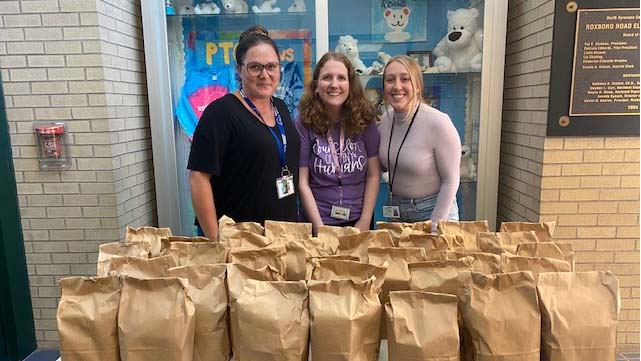Social studies teachers Matt Root and Mark Parrish wanted their Participation in Government students at Cicero-North Syracuse High School to use their mandatory community service time more meaningfully - and they found the solution in a cafeteria closet.
The North Syracuse Central School District, which contains 11 schools, boasts a median household income of $76,523, well above the statewide average of $68,304, and yet, Root and his colleague knew that 28 percent of district students were eligible for free or reduced lunches, and that many students lived in poverty.
Root and Parrish, both members of the North Syracuse Education Association, decided they could combat hunger with help from their government students. Each week, these students would use their community service hours to assemble and distribute food bags for their in-need peers. Root says the program was mind-blowing for his students. “Students couldn’t believe there were people walking around in this building without enough to eat,” he said.
According to Feeding America, children facing hunger may struggle academically and have more social and behavioral problems. They are also more likely to repeat a grade in elementary school.
The food pantry program began with 45 snack packs per week, which were distributed at the high school. Soon, word spread, and with the help of the district’s mail courier, additional schools were added to the delivery route, including several elementary schools. Root and Parrish’s students established a makeshift food pantry in a cafeteria closet, where they could store the donations from the Food Bank of Central New York and Anna’s Pantry at Sacred Heart Church.
Then COVID-19 hit, and demand skyrocketed.
At the height of the pandemic, Root and Parrish were working with union volunteers to pack 200 bags a week to feed hungry district families. River Valley Foods, a full-service grocery distributor signed up to provide weekly donations, and the team shifted from packing snacks to filling bags with ingredients to make balanced meals. In 22 weeks, the small team of volunteers distributed 60,000 pounds of food, Root says.
“What that taught me was how to do this at the school on a full-time basis,” Root says.
Last year, Root and Parrish had a team of 280 students working together to assemble and deliver 240 bags each week to food-insecure families. The program has scaled up slowly, adding new schools and more student volunteers each year – and moving out of the cafeteria closet and into a designated classroom. This year, the teachers hope to involve all 600 seniors and serve all six elementary schools, both middle schools, and C-NS High School.
Roxboro Road Elementary School was one of the first schools to sign on to the program, with help from Kerry Delduchetto, elementary school counselor and member of NSEA. “Roxboro Road Elementary is a high-needs school and the extra food at home really helps families when they can’t rely on school lunches,” said Delduchetto. “It is incredibly eye opening to see the levels of food insecurity in the community.”
Root says the project is valuable because it serves students in need, but also because it helps volunteering seniors feel like they are doing something positive for their communities. “I’m excited that kids can have this experience, and that it can change some of their mindsets,” Root said.

Making a delivery to Roxboro Road Elementary School, from left, North Syracuse Education Association members Jessica Nabewaniec, Kerry Delduchetto, and Rachel Prikazsky. Photo provided.
The program also fosters cooperation among students, who are responsible for every task related to the project, from unpacking donations at the beginning of the week to washing delivery tubs at the end of the week.
Students also reap a host of emotional benefits. “Participating in the food pantry project has great benefits for students,” said Carol Goehner, a psychology teacher at C-NS High and member of the NSEA. “The focus on the needs of others and the realization that their efforts can make someone else's life at least a bit better provides them with feelings of purpose, usefulness, and accomplishment.”
Former C-NS high school student Maddy Manz said many of her fellow seniors started off lukewarm on the idea of volunteering in the basement-level pantry, stacking boxes and packing bags. But then, those same seniors started to get feedback from the schools receiving the food – reports about how many people were being helped, and what the bags full of peanut butter, apple sauce, and oatmeal meant to the kids – and that changed everything.
“There was definitely a change in the atmosphere and a change in people’s attitude,” Manz recalls. “Now, people wanted to get down to that room, so they could help more people.”